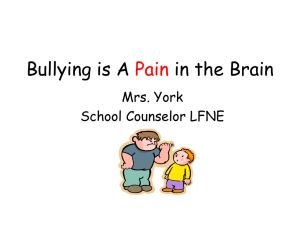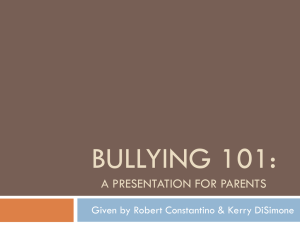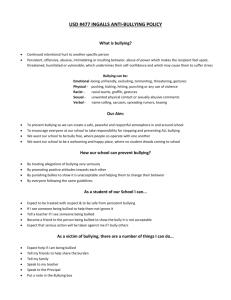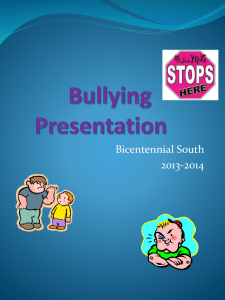Research Paper: Bullying Among Adolescents
advertisement
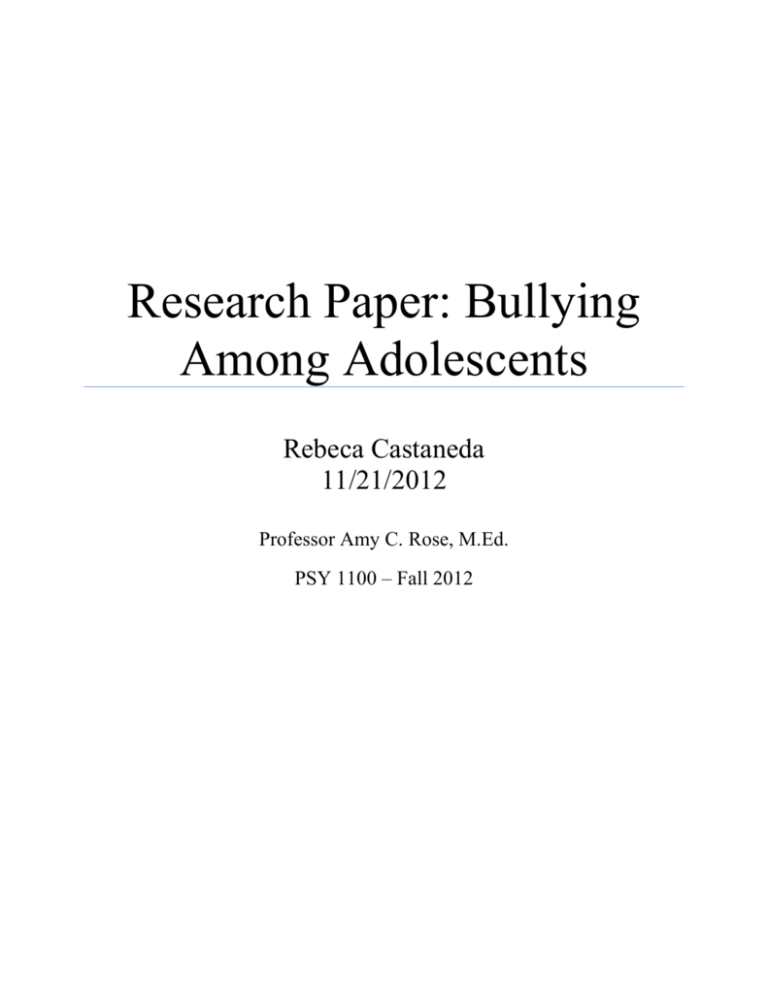
Research Paper: Bullying Among Adolescents Rebeca Castaneda 11/21/2012 Professor Amy C. Rose, M.Ed. PSY 1100 – Fall 2012 Introduction Bullying is repeated, systematic efforts to inflict harm through physical, verbal, or social attack on a weaker person (Berger, 2010, p. G-2). It occurs in every nation, at any age, and in both genders. Bullying among adolescents is challenging because not only is there the typical physical, verbal, and social abuse, but now cyber bullying has made a huge impact. Bullying has major effects, on both the bully and victim, but it is mostly the victim that has to suffer. I have always been interested in learning the types of psychological problems that the bully victims come across during their years of torment and abuse among adolescents. I have my own experiences with bullying during my adolescent years in junior high school and I can recall that it definitely left me with trauma issues that I am still working out today. Literature Review Study No. 1 Researchers Ersilia Menesini, Marco Modena, and Franca Tani, from the University of Florence, have selected 537 of the 1,278 Italian students ranging from thirteen to twenty years of age to write down their responses to a self-report bully and victim questionnaire. The students were enrolled in 13 secondary schools in the city of Lucca, Italy. The researchers then compared the concurrent psychological symptoms of 4 participant groups: bullies, victims, bullies who were also victims of bullying, and uninvolved students. Of the participants, 157 were in the bullies group, 140 were in the victims group, 81 were in the bully/victims group, and 159 were in the uninvolved students group. The results show that bullies reported a higher level of externalizing problems, victims reported more internalizing symptoms, and bully/victims reported both a higher level of externalizing problems and more internalizing symptoms. 1 (Menesini, Modena, & Tani, 2009) These researchers had two goals in mind while doing this experiment. The first goal was to analyze the relationship between involvement in bully/victim roles and concurrent maladjustment symptoms in adolescent secondary school student. The researchers hypothesized that bullies would show mainly externalizing symptoms, victims would show internalizing symptoms, and bully/victims would show both types. (Menesini, Modena, & Tani, 2009) Their hypothesis was indeed right. Their second goal was to examine the continuity and discontinuity of the bully/victim role over time. They evaluated how the stability of that role can relate to the nature and severity of the individual’s psychopathological symptoms. The researchers predicted that stable bullies, victims, and bully/victims would show more severe symptoms of being unable to adapt properly to your environment with resulting emotional instability, than would adolescents assuming these roles at a later stage. The researchers found an externalizing profile of bullies and no support for some of the more recent reports highlighting comorbidity for internalizing problems in these individuals. The results these researchers have found showed me that depending on one’s environment have a lot to do with higher rates of bullying. Study No. 2 Bullying might be of relevance for child psychiatry as it, apart from the suffering, might be a cause of future mental and relational problems in the victims and a correlate or an expression of mental problems in the bullies (Arvidsson, Broberg, Gillberg, & Ivarsson, 2005). These Researchers studied adolescents in junior high school by having them complete a questionnaire on bullying as it relates to victims, and to perpetrator status, suicide rates and biographical data. Psychological symptoms were assessed by the Youth Self Report (YSR) and the Depression Self-Rating Scale (DSRS) supplemented by school health officer’s blind 2 assessments. The results from the questionnaire showed: bully 18%, victim 10%, and bully/victim 9%. Bullies had mainly externalizing symptoms, which include delinquency and aggression. Those of the bully/victim group had both externalizing and internalizing symptoms as well as high levels of suicide. (Arvidsson, Broberg, Gillberg, & Ivarsson, 2005) Also from the result, it showed that adolescent boys were more likely to be in the bully group and to have attention problems. However, a substantial proportion of the adolescents in the victim group were judged by school health officers, it resulted in them having psychiatric symptoms and to socialize less. The results these researchers have found provided me with the knowledge of how boys would be in the bully group. I would have not assumed that because it would seem more likely that boys would act that way when they were children, but not as adolescents. Study No. 3 Being teased on a regular basis due to appearances has been associated with psychiatric morbidity in children and adolescents. The objective of this qualitative study was to explore the experiences of teasing and bullying in patients with acne, psoriasis and eczema, and the role of appearance-related teasing and bullying as mediators of psychological morbidity in these patients (Adams, Heading, Magin, Pond, & Smith). The data collected consisted of 62 in-depth semistructured interviews with patients that have acne, psoriasis, or atopic eczema. They were recruited from both specialists in dermatology and general practices. Bullying that consisted of teasing and taunting was a considerable problem for patients with a significant minority of acne, psoriasis and atopic eczema. For those who had suffered from the bullying and teasing were linked in respondents’ accounts with psychological conditions that is the consequence of a previous disease or injury, especially self-consciousness and effects on self-image and selfesteem. These researchers have found that bullying in teasing and taunting towards appearance 3 may represent an underappreciated source of psychological morbidity in children and adolescents with these common skin diseases (Adams, Heading, Magin, Pond, & Smith). The results these researchers have found make complete sense to me because teasing someone of their outward appearances will have major effects on that victim in the long run. Conclusion Some of the things I have learned from doing my research on bullying among adolescents were that teens that live in a certain environment could be more likely to have higher bullying rates than other places. This could be for many reasons. Another thing I have learned while doing my research is the fact that teasing someone about their outward appearance could cause that person to have severe damages to them, physically and mentally, which can include skin diseases. I would like to know more about why certain places have higher rates of bullying than others. The type of research that could be done in order to get my answer would be to visit the places with either high or low rates of bullying and observe the teens in their own environments. My reaction to the process of doing research and writing about it was typical because I knew what bullying was about and the effect that come with it, but I was surprised when I found all the research articles that have been done on bullying among adolescents; each one was different and each study was different. 4 References Adams J., Heading G., Magin P., Pond D., Smith W. (2008). Experiences of Appearance-Related Teasing and Bullying in Skin Diseases and Their Psychological Sequelae: Results of a Qualitative Study. Scandinavian Journal of Caring Sciences, 22(3), 430-436. Arvidsson T., Broberg A. G., Gillberg C., Ivarsson T. (2005). Bullying in Adolescence: Psychiatric Problems in Victims and Bullies as Measured by the Youth Self Report (YSR) and the Depression Self-Rating Scale (DSRS). Nordic Journal of Psychiatry, 59(5), 365-373. Berger K. S. (2010). Invitation to the life span. New York, NY: Worth Publishers Menesini E., Modena M., Tani F. (2009). Bullying and Victimization in Adolescence: Concurrent and Stable Roles and Psychological Health Symptoms. The Journal of Genetic Psychology: Research and Theory on Human Development, 170(2), 115–133. 5



